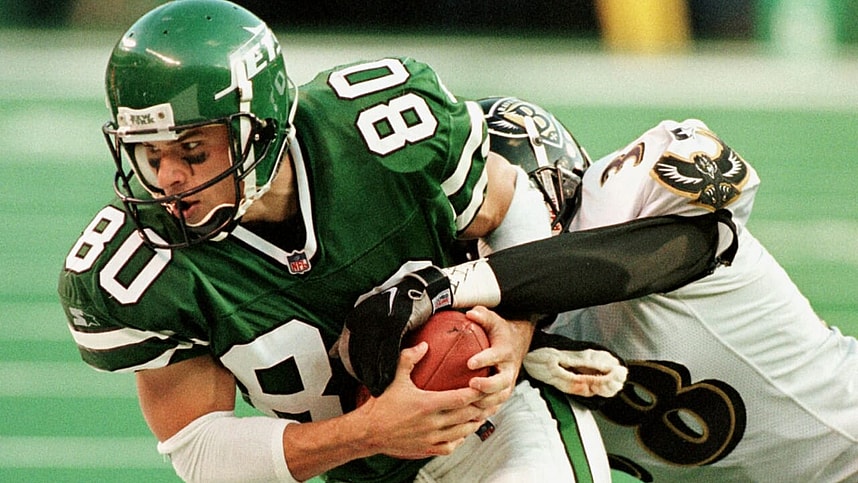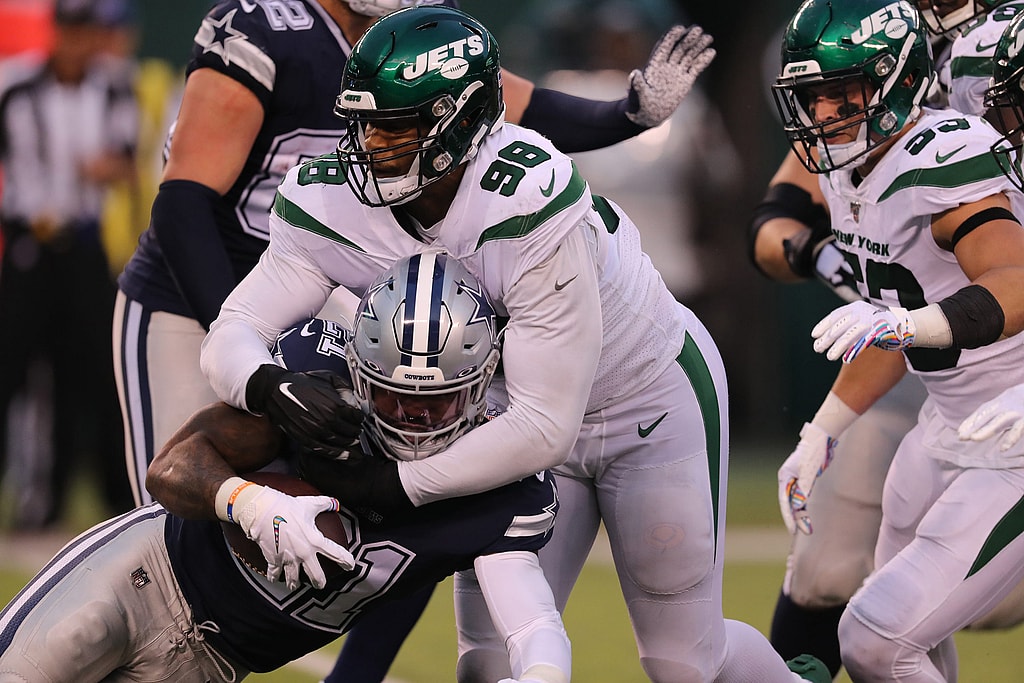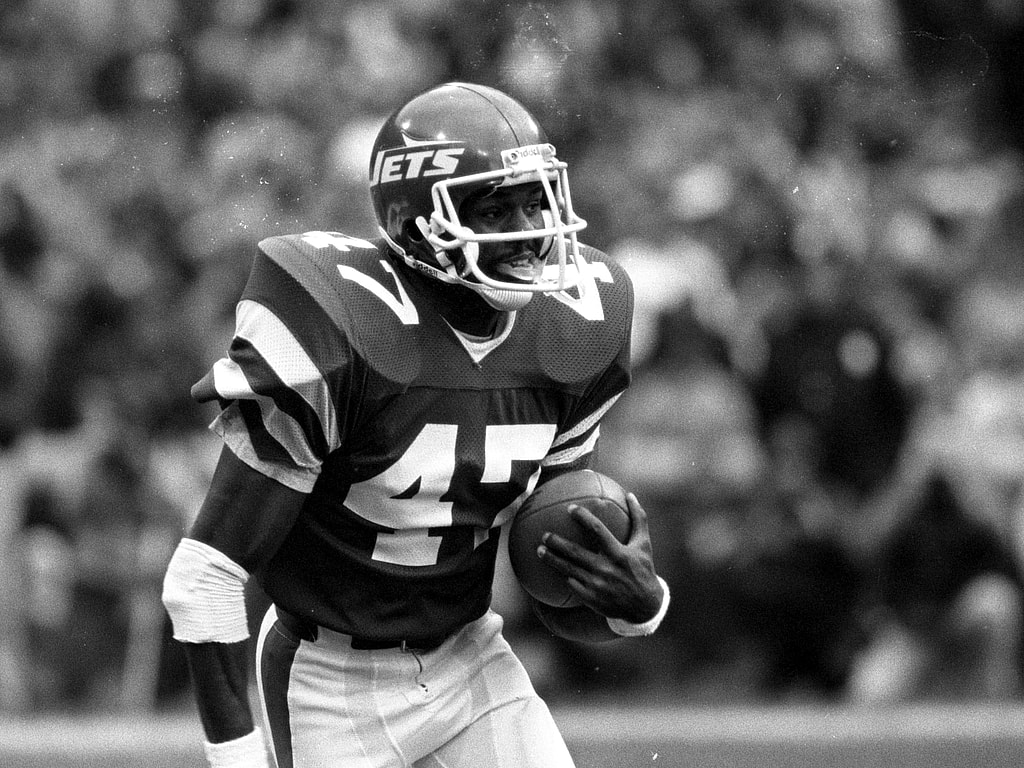
With the Easter season in full swing, the New York Jets have managed to find some hidden eggs after the NFL Draft’s final name.
255 names will be called during the process of the 2020 NFL Draft, which will begin on April 23 (8:00 p.m. ET, ESPN/ABC/NFL Network). After the draft, however, many more will get a long-awaited phone call. Several of these players could wind up becoming hidden Easter eggs, players that become remarkable contributors to the active roster.
The New York Jets have had a good share of these spring surprises roll in from the ranks of the undrafted. ESM is proud to immortalize those names in a commemorative starting lineup….
QB: Bill Demory (1973-74)
Jets history is extremely shallow on undrafted quarterback success. 1999’s supersub Ray Lucas nearly made the list, but his career began during Bill Parcells’ New England years. Demory is the only undrafted quarterback originally signed by the Jets to win a start for the squad, riding a 132-yard day from John Riggins while he went 1-for-7 for 11 yards in a 9-7 win over New England in 1973.
RB: Clark Gaines (1976-80)
Gaines was a man of many talents with the Jets. Not only was he known for his rushing talents, but the 17 receptions he earned during a 1980 loss to San Francisco still stands as a Jets franchise record. His 55 receptions in 1977 were good for third in the NFL. On the ground, the 724 rushing yards earned during his rookie season allowed him to reach the NFL’s All-Rookie Team alongside linebacker teammate Greg Buttle and future legends Steve Largent and Harry Carson. Gaines wound up gaining 2,552 yards over five seasons with the Jets before injuries derailed his career.
https://www.youtube.com/watch?v=d88_Tae7N4U
WR: Wayne Chrebet (1995-2005)
One of the renowned fan favorites in modern Jets history, Chrebet was the perfect tri-state area success story. Born in Garfield, New Jersey and graduating from Hofstra University on Long Island, Chrebet’s odds were stacked against him from the literal first moment he entered the Jets’ facility. The security guard on duty thought Chrebet was too small to partake in practice, but Chrebet defied all the odds by not only making the team but leaving a lasting impact. Currently, Chrebet ranks third in team history in receiving yardage (7,365) and touchdowns (41). He continues to be a regular prescience on Jet game days and was inducted into the team Ring of Honor in 2014.
WR: Robby Anderson (2016-19)
Anderson is by far the most prolific Jets receiver since his NFL entry. He put up 3,059 yards to accompany 20 touchdowns over four New York seasons. That’s not bad at all for a guy who entered his first Jets training camp ninth on the receiver’s depth chart. A prolific preseason (13 receptions, 264 yards) was only a sign of things to come. Anderson is currently 11th amongst active receivers with 14.8 yards per reception. Alas, the receiver has left for bluer pastures, rejoining former Temple head coach Matt Rhule and quarterback P.J. Walker in Carolina.
WR: Lou Piccone (1974-76)
As a Vineland native, Piccone’s green antics wasn’t the first time he brought a New Jersey crowd to its feet. He wound up leading the NFL in kick return yards during the 1974 season. His first professional touchdown came in two seasons later on a punt return during a shutout win over Tampa Bay. Piccone’s Jets career ended shortly after, as he shifted his New York allegiance over to Buffalo.
TE: Jeff Cumberland (2010-15)
It took a while for the Jets to unlock Cumberland’s true potential, but he became a favorite target no matter who was playing quarterback for the Jets between 2012 and 2014. Cumberland was one of two players to reach four digits in yardage in that span (the other being Jeremy Kerley) and no one scored more touchdowns (10) over that three-year range. His most notable tally, a one-yard fourth quarter grab from Greg McElroy, gave the Jets a 7-6 win over Arizona in December 2012.
C: John Schmitt (1964-73)
Another Hofstra alum, Schmitt was born in Brooklyn and first graduated from Seton Hall Preparatory School in West Orange. Schmitt was named to two All-AFL teams and was the Jets’ starting center for their victory in Super Bowl III. He would finish his career with another green team during his 1974 season with the Packers.
G: Brandon Moore (2002-12)
Moore’s lasting legacy will unfairly be the titular rear end mentioned in Mark Sanchez’s infamous “Butt Fumble”. After failing to make the team at the end of 2002 training camp, Moore partook in NFL Europe (Scottish Claymores) and the Arena Football League (Carolina Cobras) before making the most out of a second opportunity with the Jets. Curtis Martin led the league in rushing during his first full year as a starter (2004) and Moore would later be invited to the 2012 Pro Bowl.
G: Kerry Jenkins (1997-2001)
Jenkins is perhaps best-known for starting on the Tampa Bay Buccaneers’ championship offensive line in 2002, but, prior to that, he started all 48 games over the 1999-2001 seasons.
T: Matt Willig (1993-95)
Willig wound up playing 13 years in the NFL (and was a part of the St. Louis Rams’ 1999 championship squad) but the Rose Bowl champion is perhaps better known for his film career. He most recently appeared in the Warner Bros./DC Comics collaboration Birds of Prey, four years after he had a recurring role in the Marvel Cinematic Universe television entry Agents of S.H.I.E.L.D. Other popular films on his filmography include The Benchwarmers, We’re the Millers, and Stretch.
T: Brent Qvale (2014-19)
Qvale recently signed with the Houston Texans, but was a serviceable depth option over five seasons. His brother Brian currently partakes in Italian basketball and is the Big South Conference’s all-time leader in blocks.
DL: Damon Harrison (2012-15)
Affectionately known as “Snacks”, Harrison was an NAIA All-American at William Penn, but the small Iowa college hadn’t sent anyone to the NFL since 1987. He wound up making the team in 2012 and then permanently took over the Jets’ starting defensive tackle spot after injuries rocked the lineup in his sophomore season. His NFL introduction came in an October 2013 win over New England, where his first NFL sack victimized Tom Brady. Harrison would then play two-plus seasons with the Giants before a 2018 trade sent him to Detroit. He remains a fan favorite amongst metropolitan green and blue fans alike.
DL: Mike DeVito (2007-12)
DeVito probably could’ve filled several slots on this list, as the Atlantic 10 legend was known for appearing on both sides of the ball. He made his first NFL squad by beating out veterans Bobby Hamilton and Kimo Von Oelhoffen. NBC recently replayed the game that featured the biggest moment of DeVito’s career, the 2011 opener against the Dallas Cowboys. DeVito’s sack of Tony Romo (the first full QB takedown of his NFL career) forced a fumble deep in Jets territory that kept Dallas off the scoreboard and allowed a comeback to continue. The Jets won the game 27-24.

EAST RUTHERFORD, NEW JERSEY – OCTOBER 13: Defensive Lineman Kyle Phillips #98 of the New York Jets makes a stop call against the Dallas Cowboys in the second half at MetLife Stadium on October 13, 2019 in East Rutherford, New Jersey. (Photo by Al Pereira/Getty Images)
DL: Kyle Phillips (2019-present)
When injuries rocked the Jets’ defense, Phillips wound up being a serviceable replacement. His first full NFL sack came in a big situation, helping New York secure a December win over playoff contenders from Pittsburgh with a sack of Devlin Hodges late in the fourth quarter. He finished the season with 39 tackles overall.
LB: Chad Cascadden (1995-99)
Cascadden was mostly used as a depth option during his five seasons in green, but contributed to the Jets’ 1998 magic in a memorable way. He helped the Jets continue a six-game winning streak to end the regular season with the 23-yard return of a Dan Marino fumble that served as the de facto game-winning touchdown in a 21-16 win in Miami. Cascadden would also tally the only multi-sack game of his career during the 1999 AFC Championship Game against Denver.
LB: Paul Crane (1966-72)
Another Super Bowl III participant, Crane’s most notable moment came in the Jets’ first game after their ultimate triumph in Miami. He intercepted two passes, returning one for a touchdown, in the Jets’ 33-19 win over Buffalo to open up their 1969 campaign.
LB: Kevin McArthur (1986-89)
A Lamar alum, McArthur had two interceptions over a four-year Jets career. One of them came during the 1986 AFC playoffs. His 21-yard swipe of a Todd Blackledge pass went for a touchdown and was among the last of 28 unanswered points as the Jets rolled to a 35-15 win over Kansas City.
LB: Jamaal Westerman (2009-11)
A decade-plus career that spanned ten teams and two countries began collegiately at Rutgers and professionally with the Jets. Westerman immediately impressed then-head coach Rex Ryan, who predicted that Westerman would make the team in June minicamp. He immediately vindicated Ryan’s confidence with a sack in his debut, a 24-7 win over Houston to open the 2009 campaign. Another career highlight for Westerman was a two-sack output against Brady and the Patriots during a 2011 visit to Foxboro.
DB: Randy Beverly (1967-69)
One could argue that it should’ve been Beverly walking away with Super Bowl III MVP honors. The Baltimore Colts planned to pick on the inexperienced and undersized defender, but he instead haunted them with two interceptions, one of which came on the opening drive. Both interceptions also stifled Baltimore scoring chances, each occurring in the end zone. Beverly’s later career included an appearance with another New York football team, the Stars of the World Football League.
DB: Bill Baird (1963-69)
Yet another Super Bowl champ, Baird played his college ball at San Francisco State. He would go on to earn 34 interceptions over his seven NFL seasons, including eight alone during the 1964 trek. Together with Beverly and Johnny Sample, Baird would unite to allow only 181 yards between Earl Morrall and Johnny Unitas, also forcing four interceptions on the fateful evening.
DB: Dainard Paulson (1961-66)
A legacy member of the New York Titans, Paulson’s magnum opus was the 1964 season, where he put up a franchise-record 12 interceptions, which is also good for third-best in AFL/NFL history. He would follow it up with seven more a year later, reaching the AFL Pro Bowl in both years.Â

OCTOBER 9, 1983 CLEVELAND, OH: Cornerback Jerry Holmes #47 of the New York Jets returns an interception during a game against the Cleveland Browns on October 9, 1983 at the Cleveland Municipal Stadium. Cleveland won 10-7. (Photo by: Ron Kuntz Collection/Diamond Images/Getty Images)
DB: Jerry Holmes (1980-83, 86-87)
After serving as a depth option during his rookie campaign, Holmes worked his way into the Jets’ starting lineup and wound up posting 14 interceptions over five seasons as a regular. His best season (six interceptions in 1986) came after a two-year sabbatical in the United States Football League. One of those years featured three more Jersey picks as a member of the Generals. In fact, the USFL negotiated his NFL release the year before, but that did nothing to slow Nelson down. In a de facto lame duck situation (before spending his first USFL season with the Pittsburgh Maulers), Nelson helped seal an upset win over the 49ers by taking a Joe Montana pass back for a touchdown in the fourth quarter.
K: John Hall (1997-2002)
Despite a successful kicking career at Wisconsin, Hall went unclaimed until the Jets came calling. He would go on to establish himself as a clutch NFL kicker. For example, he booted the famous winner in the Monday Night Miracle against Miami). Four AFC Special Teams Player of the Week Awards also awaited him throughout his career, as did a surprising 18 tackles over six Jets seasons. In a rather obscure stat, the Jets were 3-1 in the four games where Hall had multiple tackles.
P: Ben Graham (2005-08)
In 2005, Graham, formerly of Australian Rules Football, became the oldest rookie to appear on an NFL roster at 31. He also made history in New York as the first Australian player to captain an American football team. Further football history awaited him beyond his green endeavors, as he became player to partake in both an AFL Grand Final and a Super Bowl as a member of the Arizona Cardinals.
Geoff Magliocchetti is on Twitter @GeoffJMags
More about: NFL New York Jets